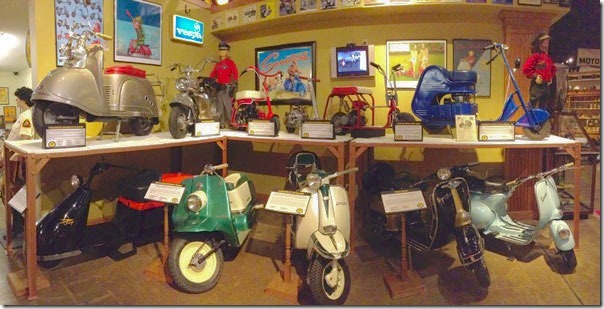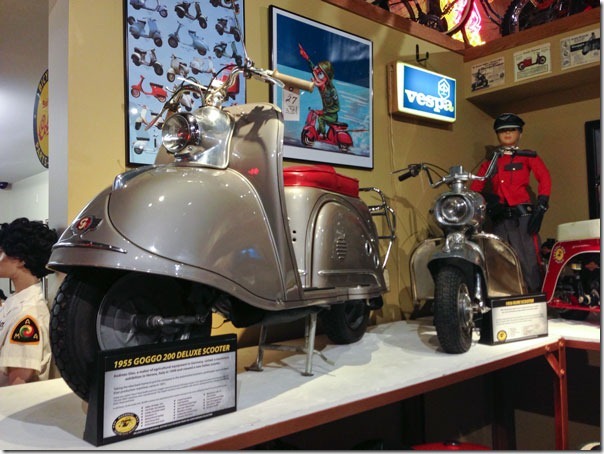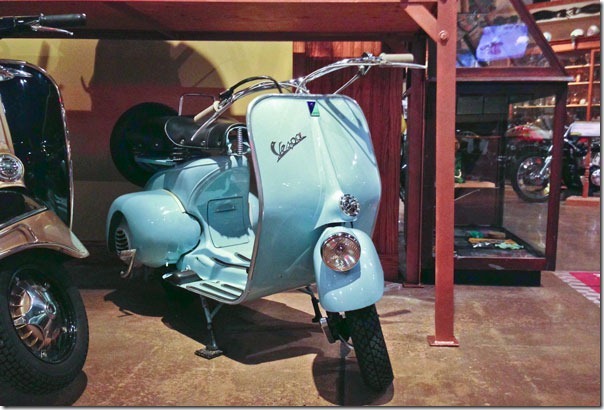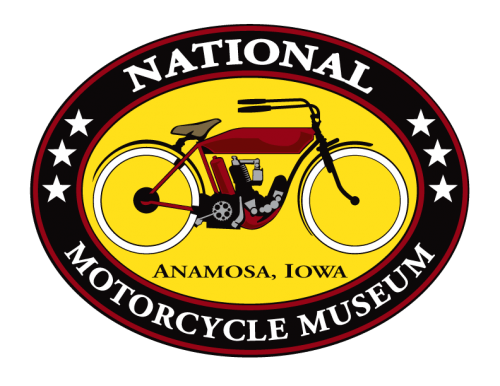SCOOTERS! One of Two Great New Temporary Exhibits at the National Motorcycle Museum

When you visit the National have some fun in the new Scooters! exhibit. Look over the rare and interesting Salsbury, an innovative design from the late 1920’s, or study the tiny Doodlebug, made in Iowa. There is even a rare and stunning Rumi, an all polished aluminum two-stroke twin scooter made in Italy.
The Salsbury Aero Model Motor Glide is one of the oldest scooters on display, originally designed and produced in 1938. Salsbury was an inventive person and applied his ideas and skills to the driveline. Instead of a multi-speed transmission you manually shift, the engine and final drive each have a pulley with moveable sheaves, moveable flanges. As engine and scooter speed increase, the flanges on the engine move closer together forcing the drive belt out creating a higher “gear ratio.” The scooter accelerates as engine speed stays constant. The styling of the Salsbury is almost as remarkable as the drive train.
Today we know that Victory and Indian motorcycles are manufactured in Iowa, but even decades ago, Iowa had a motorcycle industry. The Doodlebug, Argyle and Egley scooters were all manufactured in Iowa. The Doodlebug was probably meant for use around one’s property as it’s only about 2.5 horsepower. The Egley is a bit more powerful, has a longer wheelbase and could be used for several mile jaunts much as today’s scooters are employed. The Argyle could be taken along in the trunk of a car, even packed onto a small aircraft.

The Italian firm, Rumi, perfected an interesting two-stroke air-cooled parallel twin of 125cc’s. While most know of that engine being using in touring and sport Rumis of the 1950’s, it also powered a very spectacular scooter. All body parts are polished aluminum which along with a hot 125cc twin engine makes for a dazzling scooter.
When you think scooter, you think “compact.” Argyle scooters were unique for their all-aluminum construction, though some earlier versions used steel frames. Engines were two-stroke Power Products of 2.5 horsepower offering strong performance for such a small package. Drive is via belt and chain with a centrifugal clutch system. At 54 pounds, and foldable to a small package they were convenient to private pilots or car drivers who needed a runabout in a local area.
Harley-Davidson saw the potential in scooters as well. In response to the post-World War II scooter craze, Harley-Davidson developed the Topper and released it for sale in 1961. Its CVT, continuously variable transmission, light weight and maneuverability made it easy to ride. The Topper’s flashy paint schemes were attractive to a group not currently Harley customers. It offered step through mounting which was favorable to older riders and women in skirts and a rear brake pedal familiar to those driving automobiles.

The sophisticated and lasting designs from the Italian firms Lambretta and Vespa, plus the striking GOGO round out the traditional offerings from Europe, but when you visit you’ll find out what other scooters are on view. But only through April, 2014 when this temporary exhibit will be replaced by another.
3
replies
Trackbacks & Pingbacks
-
[…] this Salsbury for sale in Anamosa, Iowa (looks like it’s out of the National Motorcycle Museum) with bidding up to $7,300 and the reserve not yet met document.write('here on eBay.');here on […]

Pages
- 13th Annual East Central Iowa Sidecar Rally
- 14th Annual East Central Iowa Sidecar Rally – Sept. 9, 2017
- 1909 Royal Pioneer
- 1912 Pierce Four
- 1914 Yale Twin
- 1923 Ner-A-Car Model A
- 1936 Harley-Davidson VLD
- 1939 Harley-Davidson EL "Piston Splitter"
- 1948 Indian Scout "Big Base"
- 1951 HD FL Cop Bike
- 1952 Vincent "Red" Rapide
- 1954 Harley-Davidson John Tibben's KR750 Dirt Track Racer
- 1955 Goggo 200 DeLuxe Scooter
- 1957 BSA Gold Star DBD34 Flat Tracker
- 1970 Vesco Engineering Yamaha Twin Streamliner
- 1977 Harley-Davidson XLCR
- 1990 XR1200 Jesse James Custom
- 2002 Winner
- 2003 Winner
- 2004 Winner
- 2005 Winner
- 2006 Winner
- 2007 Winner
- 2008 Winner
- 2009 Winner
- 2010 Winner
- 2011 Winner
- 2012 Motorcycle Cannonball
- 2012 Vintage Bike Show
- 2012 Vintage Rally
- 2012 Winner
- 2013 Vintage Rally
- 2013 Winner
- 2014 Winner
- 2015 Winner
- 2016 Winners
- 2017 Winners
- 2018 Winners
- 2019 Winners
- 2020 Winners
- 2021 Winners
- 2022 Winners
- About
- Allstate Motorcycle Insurance Quarter MileStones
- And the Winner is…
- Barn Find
- Baxter Cycle Annual Open House and Motorcycle Auction, August 20, 2016 – Saturday Only
- Bessie Stringfield, Southern Distance Rider
- Best of the Best Gallery
- Careers
- CHOPPER STORY and 2 WHEELS+MOTOR
- Closing out March, Women's (Motorcycling) History Month…
- COMING SOON
- Davenport AMCA Swap Meet 2012
- David E. Allison Memorial Ride – June 17, 2017
- Dirt Riding USA, presented by J&P Cycles
- Distinguished Gentlemans's Ride
- Donate to the National Motorcycle Museum
- Donations/Gifts
- Donnie Smith Bike & Car Show, St Paul, Minnesota, April 2-3, 2016
- Early American Transportation Innovation
- Featured Articles
- Featured Bike: 1972 Triumph X75 Hurricane
- Featured Bikes
- Featured Motorcycle: 1977 Triumph T140 Dirt Track Racer – Raced by Gary Scott
- Featured Motorcycle: The 1974 Ducati 750 Super Sport
- Featured Rider: Dick Klamfoth
- Featured Rider: Grand National Champion Jay Springsteen
- Featured Rider: John Tibben
- FTP Upload
- Harley-Davidson XR750 Cut away bike
- Home
- Honda Dream 50R
- HURRY – Time is Running Out to WIN This Motorcycle!
- International Motorcycle Show – Washington D.C. – Jan 6-8
- International Motorcycle Show – Cleveland, Ohio – Jan 27-29
- International Motorcycle Show – Dallas, Texas – Jan 13-15
- International Motorcycle Show – Minneapolis, Minnesota – Feb 3-5
- International Motorcycle Show, Chicago February 12-14, 2016
- International Motorcycle Show, Chicago, Illinois – Feb 10-12
- International Motorcycle Show, Minneapolis February 5-7, 2016
- Iron Invasion – October 1, 2016
- Iron Invasion – October 4, 2014
- J&P Cycles Iowa Rally 2017 – June 24-25
- Jay Springsteen's MX250 short track racer
- Job Requests
- Loan A Motorcycle
- Mama Tried Motorcycle Show, Milwaukee, Wisconsin February 19-21
- Mama Tried Motorcycle Show, Milwaukee, Wisconsin – Feb 17-19
- Mecum Las Vegas Motorcycle Auction – Jan 25-28
- Mecum Motorcycle Auction – June 1-3, 2017
- Midwest Hill Climbers 67th Annual Hill Climb – Sept. 10, 2017
- Motomice Author, Paul Owen Lewis Book Signing – July 1, 2017
- Motorcycle Cannonball Coast to Coast Endurance Run – Sept 5 – 21, 2014
- Motorcycle Cannonball Endurance Run – Sept 6 – 23, 2018
- Motorcycle Club Sponsorships
- Motorcycles
- Museum Guest Register
- Newsletter Sign up!
- Newsletter test page.
- ORGAN DONATION SAVED MY LIFE
- Parts Girl Promotions Motorcycle Swap Meet – March 5
- Parts Girl Promotions Swap Meet, March 6, SUNDAY ONLY!
- Pate Swap Meet, Fort Worth, Texas – April 27-30
- Previous Winners
- Progressive International Motorcycle Show – Chicago, IL – Feb 9-11, 2018
- Retro Rewind – January 10, 2015
- Retro Rewind – January 6, 2018
- Retro Rewind: Cars & Guitars – Jan 7
- Ride to Sturgis
- Rod & Custom Car Show, Monticello, Iowa – Feb 25-26
- Scooters!
- Sisters’ Centennial Motorcycle Ride – Here on July 11, 2016
- Stay Tuned for Our 2020 Fundraiser Bike
- Tall Corn Run Ride Event for Iowa Riders Announced
- test1234
- The "Barn Job"
- The 31ST Annual Dennis Kirk Donnie Smith Bike Show – March 24-25, 2018
- The Midwest Hillclimber's 66th Annual Hill Climb
- The Midwest Hillclimbers 67th Annual Motorcycle Hill Climb – June 4th
- Then Came Bronson
- Thunder Nites in Newton – July 14, 2017
- V-Twin EXPO by Easyriders – Jan 28-29
- V-Twin EXPO February 6-7, 2016
- Vintage Rally – June 10
- Vintage Rally – June 10, 2017 – Recap
- Vintage Rally – June 7 & 8, 2014
- Vintage Rally '13 Bike show results
- Vintage Rally June 20, 2015
- Vintage Rally June 4, 2016 Recap
- Vintage Rally Lodging
- Vintage Torque Fest April 29-30, 2016 Dubuque County Fairgrounds Dubuque, Iowa
- Volunteer
- Volunteer signup page
- Walneck's Swap Meet, Woodstock, Illinois – April 23
- Wauseon AMCA Swap Meet and Vintage Flat Track Races, July 15, 16 & 17 2016; Friday Through Sunday
- WIN This Classic 2015 Indian
- Win This Motorcycle!
- Wings & Wheels, An Amazing Donation to the National Motorcycle Museum
- Women & Long Distance Riding in America
- Get Involved!
- Event Calendar 2012
- Banquet Hall
- Links/Resources
- About Us
Categories
Archive
- August 2023
- July 2023
- June 2023
- May 2023
- April 2023
- March 2023
- February 2023
- January 2023
- December 2022
- November 2022
- October 2022
- September 2022
- August 2022
- July 2022
- June 2022
- May 2022
- April 2022
- March 2022
- February 2022
- January 2022
- December 2021
- November 2021
- October 2021
- September 2021
- August 2021
- July 2021
- June 2021
- May 2021
- April 2021
- March 2021
- February 2021
- January 2021
- December 2020
- November 2020
- October 2020
- September 2020
- August 2020
- July 2020
- June 2020
- May 2020
- April 2020
- March 2020
- February 2020
- January 2020
- December 2019
- November 2019
- October 2019
- September 2019
- August 2019
- July 2019
- June 2019
- May 2019
- April 2019
- March 2019
- February 2019
- January 2019
- December 2018
- November 2018
- October 2018
- September 2018
- August 2018
- July 2018
- June 2018
- May 2018
- April 2018
- March 2018
- February 2018
- January 2018
- December 2017
- November 2017
- October 2017
- September 2017
- August 2017
- July 2017
- June 2017
- May 2017
- April 2017
- March 2017
- February 2017
- January 2017
- December 2016
- November 2016
- October 2016
- September 2016
- August 2016
- July 2016
- June 2016
- May 2016
- April 2016
- March 2016
- February 2016
- January 2016
- December 2015
- November 2015
- August 2015
- July 2015
- June 2015
- May 2015
- April 2015
- February 2015
- January 2015
- December 2014
- November 2014
- October 2014
- September 2014
- August 2014
- July 2014
- June 2014
- April 2014
- March 2014
- February 2014
- January 2014
- December 2013
- November 2013
- September 2013
- August 2013
- July 2013
- June 2013
- March 2013
- October 2012
I have a 1938 moto scooter trying to find parts any idea
My grandfather was the one who invented the Egley scooter. At one time it was in your museum and I was wondering if you still had it and if it is going to be on the auction. I would certainly lover to have it back in the family. Thank you.
Patricia Rubendall
712-661-9269
patrubendall@frontier.com